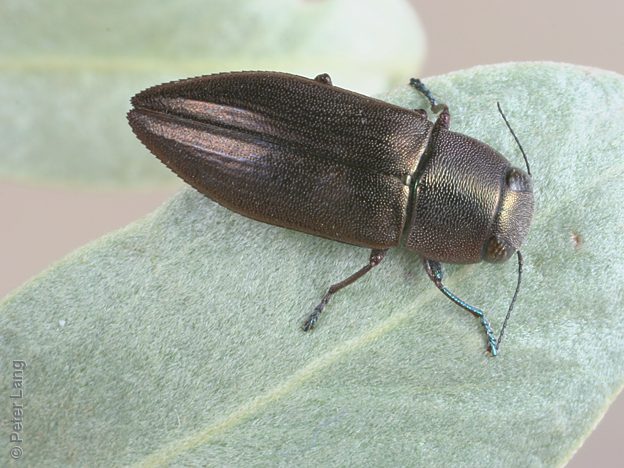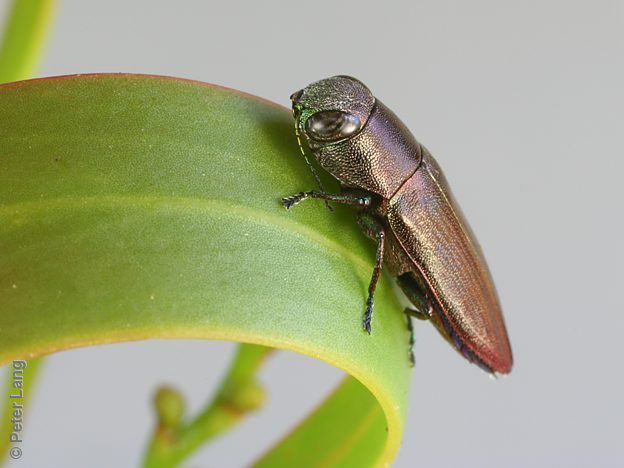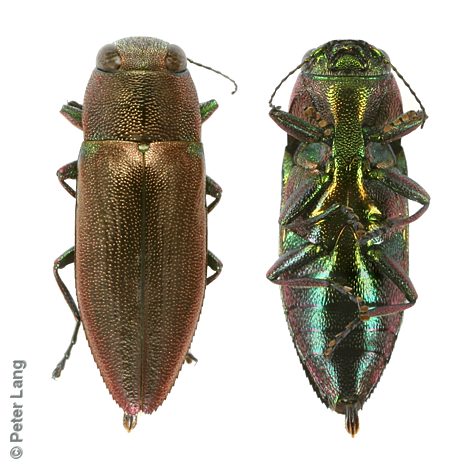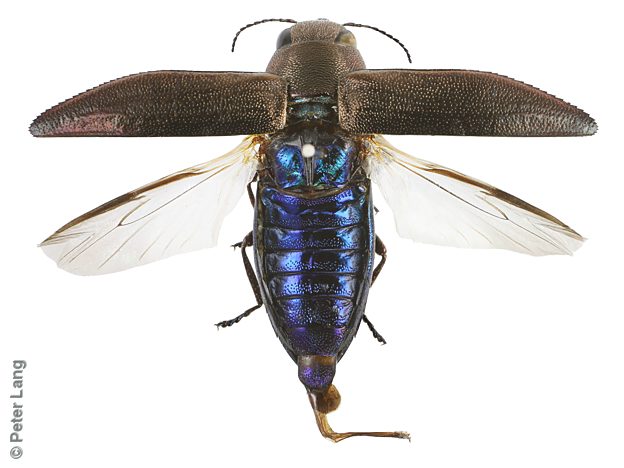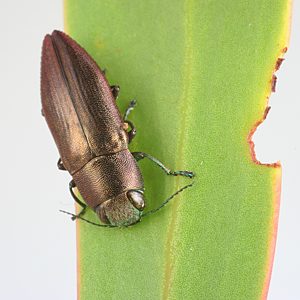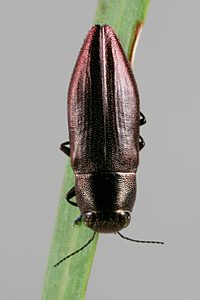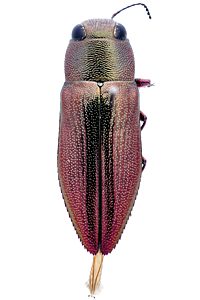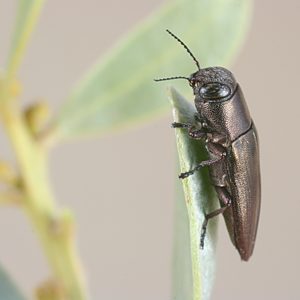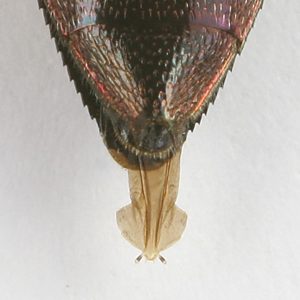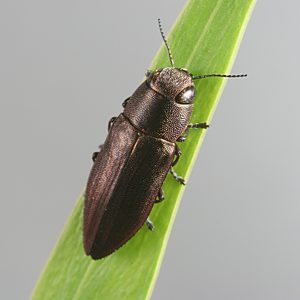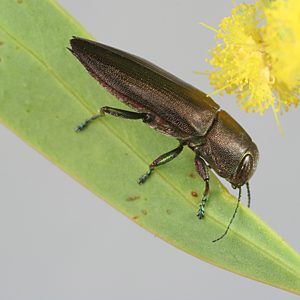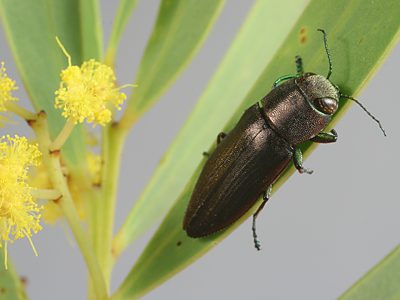Melobasis sordida Blackburn, 1887
subfamily Buprestinae » tribe Melobasini » subtribe Melobasina
Melobasis species group: nervosa
Melobasis sordida Adult images
Measurements (mm)
| male | female |
|---|
| L1 | 10.3 | 8.15 – 12.9 | n = 39 | 10.7 | 8.7 – 12.15 | n = 21 |
| L2 | 10.4 | 9.25 – 12.4 | n = 13 | 10.5 | 8.5 – 11.8 | n = 6 |
| W | 3.6 | 2.9 – 4.6 | n = 39 | 3.7 | 3 – 4.2 | n = 21 |
| Legend | L1 | length from clypeus/frons to elytral apex (mean, range, sample size) |
| L2 | length from anterior of edge of eyes to elytral apex |
| W | maximum width with elytra fully closed |
Melobasis sordida Distinctive features
Bronze (to greyish-, or red-purplish- bronze) above, with substantial areas of green below in the males. Levey 2018 noted the dense tranversely 'stretched' puncta in the middle of the pronotum as a diagnostic feature of this species.
Notes
Melobasis sordida is common in the Adelaide area and over much of SA where it is found on the foliage of various Acacia species. Carter 1929 placed M. sordida in synonymy under M. simplex, but the two are distinct species and they have been assigned to different species groups by Levey 2018. This is in accordance with mitochondrial DNA (CO1) sequences that I obtained as part of a SA Museum project.
Distribution
NU, FR, EP, NL, MU, YP, SL, SE
Australian States: WA, SA, VIC, NSW, QLD
South Australian occurrences
| Legend | | P.J.Lang collection vouchered records |
| other private collection or museum specimens, or sightings |
Adult activity records for Melobasis sordida (total actual records: 162 beetles)
|
|
|
|
|
|
|
|
|
|
|
|
|
|
|
|
|
|
|
|
|
|
|
|
|
|
| Jul |
Aug |
Sep |
Oct |
Nov |
Dec |
Jan |
Feb |
Mar |
Apr |
May |
Jun |
| Legend | |
| number of active beetles, actually recorded in that quarter-month |
| actual count > 6 (median) |
| actual count <= 6 (median) |
Adult host plants
| Acacia pycnantha | 79 | 21 | FR, EP, NL, MU, SL, SE | F |
|
| Acacia calamifolia | 20 | 6 | FR, EP, NL, MU | F |
|
| Acacia euthycarpa | 16 | 7 | FR, EP, MU | F |
|
| Acacia retinodes | 16 | 4 | NL, MU, SL | F |
|
| Acacia ligulata | 4 | 1 | MU | F |
|
| Acacia victoriae ssp. victoriae | 4 | 3 | FR, NL | F |
|
| Acacia argyrophylla | 3 | 2 | MU | F |
|
| Acacia sp. | 2 | 1 | NU | F |
|
| Acacia cyclops | 2 | 2 | MU, YP | F |
|
| Acacia quornensis | 2 | 1 | EP | F |
|
| *Acacia baileyana | 1 | 1 | SL | F |
|
| *Acacia iteaphylla | 1 | 1 | NL | F |
|
| *Acacia saligna | 1 | 1 | SE | F |
|
| Acacia sp. Winged (C.R.Alcock 4936) | 1 | 1 | YP | F |
|
| Beyeria lechenaultii | 1 | 1 | MU | E |
|
| Callitris gracilis | 1 | 1 | MU | C |
|
| Cassinia sp. | 1 | 1 | FR | A |
|
| Pittosporum angustifolium | 1 | 1 | MU | P |
|
| Senna artemisioides ssp. petiolaris | 1 | 1 | EP | F |
|
| Legend | beetles | count of beetles collected from, or sighted on, host plant taxon |
| sites | count of major sites (unique 10 km grid cells +/- some distinct approximate localities) |
| * | indicates alien (non-native) plant occurrences, either wild or planted (the species may be alien in SA, or native in parts of its SA range) |
| Plant names in green are hyperlinked to a matching host species page with plant photos. |
Plant family
| F |
Fabaceae |
152 |
97% |
13 |
| A |
Asteraceae |
1 |
1% |
1 |
| C |
Cupressaceae |
1 |
1% |
1 |
| E |
Euphorbiaceae |
1 |
1% |
1 |
| P |
Pittosporaceae |
1 |
1% |
1 |
Position on adult host
|
| on flowering plant | | 5 | 4 |
| on foliage or non-flowering plant | | 145 | 38 |
| on plant (unspecified) | | 6 | 5 |
| other |
| on stems | | 1 | 1 |
Larval host plants
| Legend | records | count of breeding adults, pupae and larvae |
| sites | count of major sites (unique 10 km grid cells +/- some distinct approximate localities) |
| adult | live = extracted alive; dead = extracted dead as intact or fragmentary remains; ex billet = reared and emerged from stored sections of host; ex pupa = reared from sampled pupa |
| pupa | extracted pupa; pupa ex larva = reared pupa from larva |
| larva | extracted larva (any stage including prepupa) |
| gall (only) | hatched or unhatched gall identified by form and position rather than contents |
| Plant names in green are hyperlinked to a matching host species page with plant photos. |
Plant family
Position in larval host
Host plant notes
The adults are foliage-feeders and have been found on a number of different Acacia species. I reared adults of M. sordida from billets cut from the dead stems of two different Acacia species: one individual from Dog Wattle (A. wattsiana) and one from A. spilleriana. It is likely to breed in many other Acacia species.
| ¹ Legend | regions | SA State Herbarium regions (map)
EA: Eastern, EP: Eyre Peninsula, FR: Flinders Ranges, GT: Gairdner-Torrens, KI: Kangaroo Island, LE: Lake Eyre, MU: Murray, NL: Northern Lofty, NU: Nullarbor, NW: North-Western, SE: South-Eastern, SL: Southern Lofty, YP: Yorke Peninsula |
| size | The ellipse is the correct size when printed, indicative on a desktop screen, and likely to be wrong on a mobile device. |
